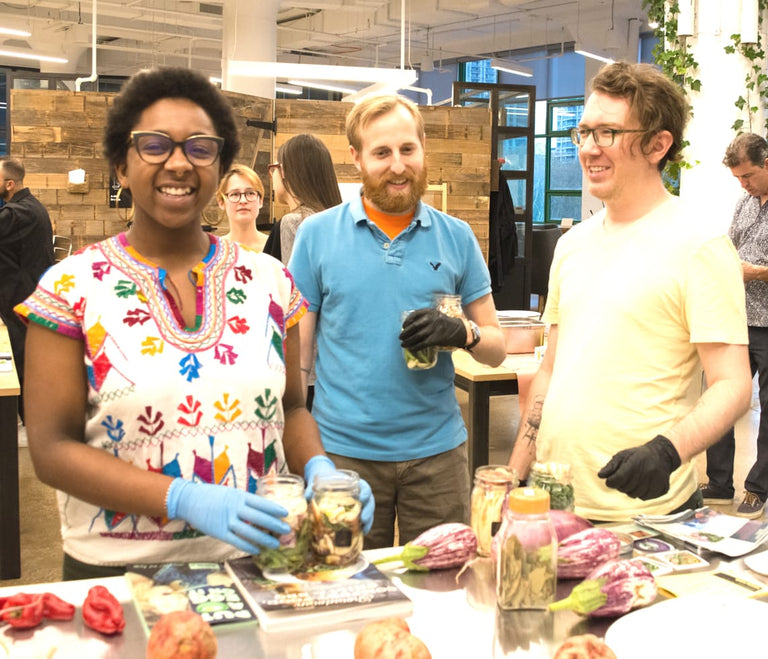A Guide to Ramp Foraging Practices

Ramps, whether you know them from chic restaurant menus or don’t know them at all, deserve some credit. These wild alliums have survived entirely on their own for hundreds of years, reliably rearing their heads to announce the beginning of spring.
Ramps, or Allium tricoccum, are a wild onion native to Eastern North America, growing in the deciduous forests from Quebec to Georgia and west to Minnesota. They’re one of the first plants to sprout in the spring, around April to May. Once the trees form their leaves, the ramps are shaded out, causing the leaves to wilt and the bulbs to form ramp scapes, and eventually flowers, and finally, seeds. The ephemerality of ramps is what makes them so sought after by chefs and home cooks alike. All parts of the plant save for the roots are edible, from their flat, glossy leaves, to the reddish stem, down to the white bulb. They can be enjoyed both raw and cooked. Their taste is often described as hovering between garlic and onion, yet transcending both. “Pungent” comes up a lot, too. According to the 1974 Southern Appalachian Mountain Cookin’ family recipe book, “the odor of ramps makes garlic smell like Chanel No. 5.”
While they have long been consumed as a vernal tonic by the Cherokee and European-Americans, celebrated in local festivals by Appalachian communities, and adored by foragers, only in the past couple decades have they burst onto the fine dining scene. That’s right – ramps only really garnered national attention starting in the late 1990s – but their story and cultural value in the U.S. goes back much further. Before they were the talk of the town for urban-dwelling restaurant-goers, ramps were eaten more or less exclusively by mountain communities and by anyone keen on foraging for themself. Folk traditions, music, family traditions and childhood memories likely have richer stories to tell us about ramps than the big news sources of today can. For example, one local West Virginia publication recalls a series of pranks pulled off with the help of ramps.
Our means of obtaining ramps has changed a lot between then and now. Today, we can buy them from farmers markets and farm box subscription services (like us!), while restaurants might hire professional foragers. Yet historically, foraging has been a way to connect with the land and have a real relationship with the food you eat. What happens to this connection when we purchase foraged foods? One risk is that we don’t pay attention to sustainability or long-term effects of our purchases. When demand for ramps has the potential to outpace supply, it’s important for us to ask questions about where our ramps come from and how they’re harvested.
If you’re only out for the leaves, we’ve got good news! Leaving the bulb in the ground while just cutting the green tops is the most sustainable way to enjoy ramps - but it’s pretty hard to find these bulbless leaves at the market. Fortunately, you can have your bulbs and eat them, too, if you know what kind of sustainable foraging practices to look for. It starts with clumps.
Ramps grow in clumps. One clump can have anywhere from five to thirty ramps. Our partner forager Samuel explained that by taking only around 50-65% from each clump, they can be sure that they’ll have full regeneration for the following year. There are two ways that ramps can reproduce: by the bulb of the ramp, and by the seed. The bulb of the ramp acts like the seed, so if it’s left in the ground, it regenerates. Alternatively, the ramp produces a seed pod every other year, which drops to the ground or is dispersed by animals. Yet Samuel and his team don’t depend on this seed dispersal - they focus on leaving enough bulbs in the ground to ensure that they’re keeping their ramp count around the same level year after year.
Ramps produce a seed bulb every other year and take 6 months to 1.5 years to germinate. Sam suspects that more intensive agricultural practices, like clearcutting (completely clearing trees and plants from the land) are to blame for lower reproduction rates.
Ultimately, though, there are a bunch of different perspectives on “sustainable” ramp foraging, and no one clear answer. Some say that harvesting just the leaves is the only truly sustainable option. For others, seeing full regeneration year after year - that is, harvesting without shrinking the number of plants - is the goal. A rule to live by for all sustainably-minded foragers and eaters, though, is to only take as much as you need. Of course, “as much as you need” changes when people are not just foraging for themselves, but for a larger market. But we can still keep this guideline in mind as urban consumers of wild plants. The best way to enjoy ramps is not to stockpile but to savor them, in all their fleeting, garlicky glory.
Foraging and wild plants open up some important conversations around ecology, ethics, and our relationship with the land. Whether you’ve gotten your hands dirty digging yourself or are just discovering them now, ramps (and other foraged foods) can offer us a fresh point of connection and curiosity with our local environment. They give us a window into the history and culture of these green spaces and can also inspire interest in their conservation. It’s a conversation which necessarily includes Indigenous voices. The topic of foraging goes far beyond greens and fungi.
Back in the Western Catskills, Sam has been foraging for about a decade, while his friend, mentor and partner Jason has been doing it since he was a kid. Together, they supply NYC’s restaurants and CSAs. For them, a ramp forage means gearing up and getting dirty, trekking through woods and rocky terrain, and hauling over 80lbs of foraged edibles at a time. “It’s really labor intensive,” Sam told us. In addition to ramps, Sam and Jason forage watercress, fiddleheads, wild elderflower and wild blueberries.
Sam and his team leave their ramps intact (root hairs included) and unwashed. This keeps them at maximum freshness with the longest shelf-life possible. Their ramps go from the Catskills to your doorstep in smaller quantities in farm crates, so that the ramps are never tightly packed or smothered by uncomfy packaging. To keep them at their freshest, we recommend that you store them in your fridge, unwashed.

Need inspiration on how to use them in the kitchen? We’ve got you covered! Try them on toast, or whip up a zesty pesto. Want to have the taste of just-barely-spring on tap all year round? Pickled ramps or ramps butter are great options for preserving these wild wonders long after their season is over!
Rather have a taste first?
Local Roots Experiences are fun, pop-up events where we bring the farm to you!

Become a Harvest Club Pick Up Location
Are you a NY based cafe, bar, or neighborhood business? Become a Harvest Club pick up location and have community members come to your establishment each week to pick up their Local Roots harvest.
Top






